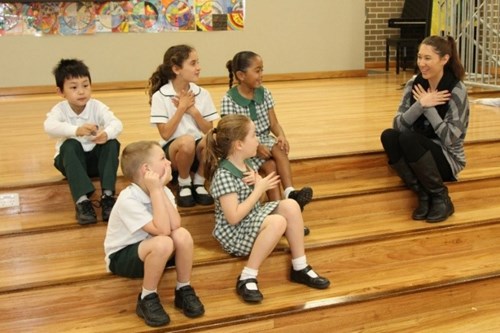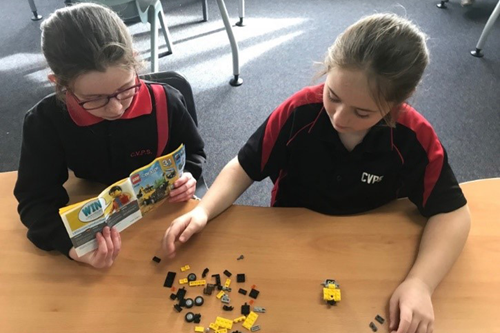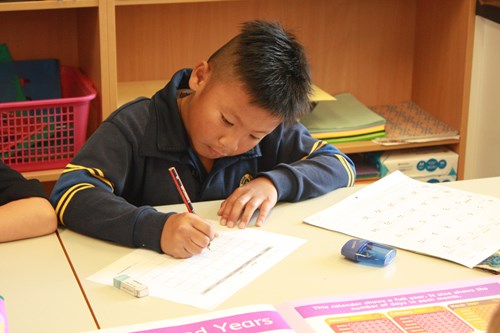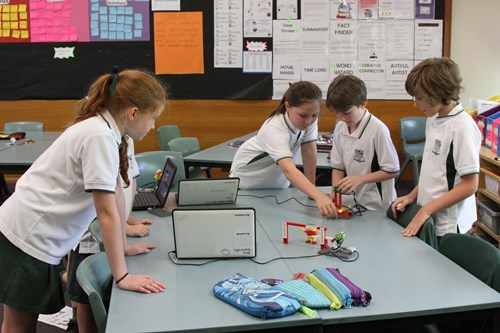This edition of Primary Matters unpacks a range of Australian Curriculum resources and new work samples published throughout 2019. Stories from curriculum specialists Caty Morris and Danielle Cavanagh showcase recently published resources that support the Aboriginal and Torres Strait Islander Histories and Cultures cross-curriculum priority and the general capabilities, and how these can be used in the primary classroom.
New Australian Curriculum resources to be published in 2020 are highlighted at the end of the edition.
In response to feedback from community and educators, ACARA published 95 new elaborations in October 2018 to help teachers to incorporate the Aboriginal and Torres Strait Islander Histories and Cultures cross-curriculum priority in the Australian Curriculum: Science. These elaborations acknowledge that Aboriginal Peoples and Torres Strait Islander Peoples have worked scientifically for millennia and continue to contribute to contemporary science.
Supporting teacher background information for Years F–6 and 7–10 are now available to assist teachers in planning and teaching culturally appropriate and scientifically rigorous learning experiences.
- Enable authentic integration of the key concepts and organising Ideas of the Aboriginal and Torres Strait Islander cross-curriculum priority.
- Add depth and rigour to content descriptions of the three strands of Science – Science understanding (SU), Science as a human endeavor (SHE) and Science inquiry skills (SIS).
- Accommodate increasingly sophisticated aspects of understanding across year levels
- Provide culturally appropriate contexts for deeper Science inquiry.
- Facilitate, where appropriate, the integration of closely related content from two or more strands at the same year level or two-year band.
- Provide additional opportunities to embed the general capabilities.
- Assist educators in opening a dialogue with local Aboriginal and Torres Strait Islander communities.
An important disclaimer accompanies all supporting teacher background information in order to guide teachers in understanding the process for consulted works and how to use the background information in culturally appropriate ways:
In the construction of this teacher background information, a list of consulted works has been generated. The consulted works are provided as evidence of the research undertaken to inform the development of the teacher background information. To access this information, please read and acknowledge the following important information:
Please note that some of the sources listed in the consulted works may contain material that is considered culturally offensive or inappropriate. The consulted works are not provided or recommended as classroom resources.
I have read and confirm my awareness that the consulted works may contain offensive material and are not provided or recommended by ACARA as classroom resources.
(ACARA, 2019)
95 Science content elaborations: printable resources
Booklet with Years F–6 teacher background information
Booklet with Years 7–10 teacher background information
Examples of Aboriginal and Torres Strait Islander Histories and Cultures Science elaborations
The Aboriginal and Torres Strait Islander Histories and Cultures illustrations of practice showcase how the priority can be embedded across learning areas. ACARA has recently published additional illustrations of practice, focusing on the two-way Science approach to teaching and learning.
The two-way Science illustrations of practice show examples of students learning about science that links Aboriginal ecological knowledge through on-Country and classroom projects aligned to the Australian Curriculum: Science. Within the illustrations are video stories of four schools embedding the two-way Science approach with supporting background information:
Two-way science at Wiluna Remote Community School, Western Australia: Years 2–4 Two-way science at Leonora, Western Australia: Years 1–2, 3–4 and 7–10
Two-way science at Mt Leibig School, Northern Territory: Years 3–6 Two-way science at Areyonga School, Northern Territory: Years 3–6
- Provide provocations on how to embed the Aboriginal and Torres Strait Islander cross-curriculum priority within learning areas.
- Explore possibilities of on-Country learning linked with the Australian Curriculum: Science.
- Assist in opening a dialogue with local Aboriginal and Torres Strait Islander communities.
- Provide a tool for self-reflection in relation to the priority, organising ideas and key concepts.

“Career education is the development of knowledge, skills and attitudes through a planned program of learning experiences in education and training settings to assist students to make informed decisions about their study and/or work options and enable effective participation in working life.”
(Australian Government Department of Education and Training, 2019. Future Ready: A student focused National Career Education Strategy)
The general capabilities career education resource was developed as part of Future Ready: A student focused National Career Education Strategy. The strategy focuses on improving career education in schools by:
- building teacher and school leader capability
- supporting parents and carers in their important role in these conversations
- encouraging collaboration between industry and schools.
The illustrations of practice developed for primary schools demonstrate:
- why the development of the general capabilities is an important part of student learning
- how the general capabilities can be included in teaching and learning experiences
- why school leaders and teachers value and plan for the inclusion of the general capabilities
- how schools develop partnerships with industry that add value to student learning
- why parents value career-related learning in primary schools
- how students articulate the connections between their learning and their aspirations for the future.
There are five illustrations of practice, which highlight the different approaches primary schools have taken towards career-related learning in a range of contexts. Primary schools from metropolitan and regional areas contributed to the resource, and each illustration provides a different approach to the curriculum. The illustrations include approaches to STEAM, STEM, entrepreneurial learning, personal development and career week celebrations and incorporate a range of general capabilities.
|
School |
Curriculum focus / career education focus |
Location |
|
STEAM and engaging parents |
Regional Tasmania |
|
|
STEM and industry partnerships |
Regional South Australia |
|
|
Entrepreneurial learning and social enterprise |
Regional Victoria |
|
|
Personal development and Career Week Celebrations |
Metropolitan Western Australia |
|
|
Personal development and informed goal-setting for the future |
Metropolitan ACT |
How can the Australian Curriculum Careers Education illustrations of practice help me in my school/classroom?
The resources developed come with a set of reflective questions that can be used by school staff when considering approaches to career-related learning. The questions focus on unpacking the published illustration or supporting schools to consider their own practice or approaches to career-related learning.
For example:
- Describe how the school [in this illustration] uses the Australian Curriculum learning areas and general capabilities to develop a career education program.
- Identify how a school-based career education program would benefit your students.
- What aspects of the Australian Curriculum could be included in your school-based career education program?
- How would you identify and include appropriate community stakeholders when developing a school-based career education program?
Illustrations of practice: primary school stories
Parent engagement: Burnie Primary School, Tasmania Industry Engagement: Crystal Brook Primary School, South Australia
Primary student engagement: Myrrhee Primary School, Victoria School leadership: Hillman Primary School, Western Australia
“In an increasingly complex, connected and rapidly changing world, it is critical for every young Australian to develop the skills needed to flourish as healthy, safe, confident and digitally literate citizens.” (ACARA, 2019)
 Before the end of the year, ACARA will add an online safety curriculum connection to the suite of curriculum connections that are already published on the Australian Curriculum website. This curriculum connection will provide information and resources for educators to create teaching and learning programs about online safety tailored to meet the needs of their school.
Before the end of the year, ACARA will add an online safety curriculum connection to the suite of curriculum connections that are already published on the Australian Curriculum website. This curriculum connection will provide information and resources for educators to create teaching and learning programs about online safety tailored to meet the needs of their school.
The curriculum connection is based around five interrelated dimensions of online safety:
- values, rights and responsibilities
- wellbeing
- respectful relationships
- digital media literacy
- informed and safe use of information and devices.
These dimensions of learning have been developed in consultation with the eSafety Commissioner and are aligned to learning areas, general capabilities and cross-curriculum priorities.
https://www.australiancurriculum.edu.au/resources/curriculum-connections/
Since our Primary Matters newsletter in June 2019, the DTiF webpage has published new resources to support the implementation and integration of the Digital Technologies curriculum across primary years of schooling. These include a range of tutorials, printable posters and activity cards, as well as a collection of classroom ideas handouts.
Recently published DTiF resources:
Classroom materials
Classroom ideas resources F–6, printable posters and activities

Image: Sample view of a selection of classroom ideas resources designed to provide inspiration for how to teach Digital Technologies
Books for exploring Digital Technologies concepts (age groups of 4–12 years)
Image: Sample view of resource: books for exploring Digital Technologies concepts
Board and card games for exploring Digital Technologies concepts

Image: Sample view of resource: board and card games for exploring Digital Technologies concepts
Planning support materials
Teacher self-assessment matrices have been designed for teachers to check their ICT capability and Digital Technologies proficiency aligned to the Australian Professional Standards for Teachers: ICT Statements for Graduate Standards.
ICT Teacher self-assessment matrix accessible through the DTiF resources webpage: planning support materials
Digital Technologies Teacher self-assessment matrix accessible through the DTiF resources webpage: planning support materials
New work samples have been published throughout 2019 for HASS F–6/7, History 7–10 and Languages: German, Korean, Modern Greek, Spanish, and Vietnamese. Work samples illustrate portfolios to demonstrate student learning in relation to achievement standards. Each portfolio comprises a collection of student work samples in response to outlined learning/assessment tasks.

Example of Year 4 HASS work samples

Example of Years 3 and 4 German work samples
How can work samples help me in my school/classroom?
- Compare work samples at different levels of achievement to assist making judgements.
- Assist in opening a dialogue about assessment principles such as validity, reliability, moderation, questioning and making on balance judgements.
- Provide a tool for self-reflection in relation to aligning learning/assessment tasks to the achievement standards.
- Provide opportunities to consider a range of learning/assessment tasks in alignment to the achievement standards.
Updated ‘Student diversity’ information
“The Australian Curriculum is an inclusive curriculum that aims to promote students’ strengths. Teachers can provide learning opportunities for all students, using a combination of the three dimensions: learning area content and/or the general capabilities, and/or cross-curriculum priorities.” (ACARA, 2019) These elements of diversity provide both extraordinary promise and potential challenges for schools.
To support school communities in the delivery of the Australian Curriculum to increasingly diverse school populations, the ‘Student diversity’ pages on the Australian Curriculum website are being revised. These revisions focus on providing succinct advice and resources to support teachers endeavoring to meet the individual needs of students in a variety of educational settings. The updated information will be published at the start of next year.
Key changes/additions to the webpages will include:
- a new introductory video (recently published on current ‘Overview’ page)
- content and illustrations of practice focused on the diversity of students in regular classrooms, with supporting teacher background information
- a new iteration of the ACARA planning flowchart, now the CASE steps, which provides planning advice in relation to appropriate content, recognition of student abilities, assessment aligned to achievement standards and planning evaluation
- links to state, territory and Nationally Consistent Collection of Data resources.
These changes to the Student Diversity section on the Australian Curriculum website have been developed with advice from members of ACARA’s Students with Disability Advisory Group and a range of specialists at ACARA.

Aboriginal Languages and Torres Strait Islander Languages illustrations of practice
ACARA continues to develop resources in Languages in addition to work samples. These will now include illustrations of practice to support language programs based on the Aboriginal Languages and Torres Strait Islander Languages Framework. The illustrations of practice will be published on the resource section of the Australian Curriculum website, aiming to exemplify current practices, implementation and flexible use of the Aboriginal Languages and Torres Strait Islander Languages Framework for developing language-specific curricula and programs for the following pathways:
- First Language Learner Pathway (L1)
- Second Language Learner Pathway (L2)
- Language Revival Learner Pathway (LR)
“Nganki - ka Kardu thipmam - wa! I Murrinh warda ngatha. The nganthin ngumpanngerren. I ku ngakumarl, da ngarra ngugumingki wurran. The da matha nganthin ngala i da bere matha wangu ngumamath ngumpan ngarra magulkul nganki.”
“We are black people. We speak our language. We have our totems and Dreamings. This is what we know and will hold always in our hearts. It is who we are.”
Deminhimpuk Francella Bunduck, Murrinhpatha teacher, OLSH Thamurrurr College, Wadeye, ACARA consultation forum, Darwin, July 2013
Curriculum connections
The curriculum connections resources: Consumer and financial literacy, Food and fibre, Food and wellbeing and Outdoor learning allow educators to draw connections across the dimensions of the Australian Curriculum on various conceptual themes. Each connection includes information about the rationale and structure of the connection and provides teachers with useful links.

International comparative studies: key findings (2019)
Key findings from the four international comparative studies – The British Columbia Curriculum, The Finnish National Core Curriculum, The Singapore Curriculum and The New Zealand Curriculum – were published earlier this year and are available on the Australian Curriculum website under the ‘Publications’ tab.
Primary Matters newsletters
In 2019, the Primary Matters newsletter editions focused on The Arts, the DTiF project and Literacy. Previous years have covered multiple themes and can be accessed via the ‘Resources/publications’ > ‘Publications’ > Primary Matters’ > ‘Archived newsletters’.

Additional Australian Curriculum resources and publications
Additional resources and publications can be located through the ‘Resources/publication’ tab on the Australian Curriculum website.

Like what you see? Subscribe to receive Primary Matters four times a year to your inbox or email story suggestions and feedback to [email protected].





















